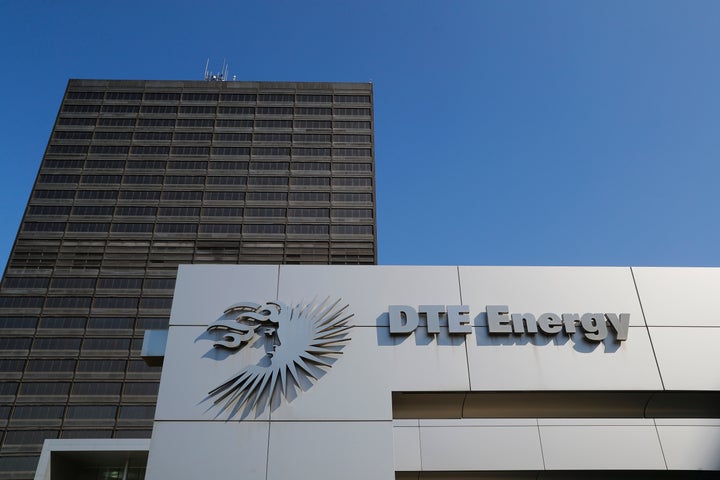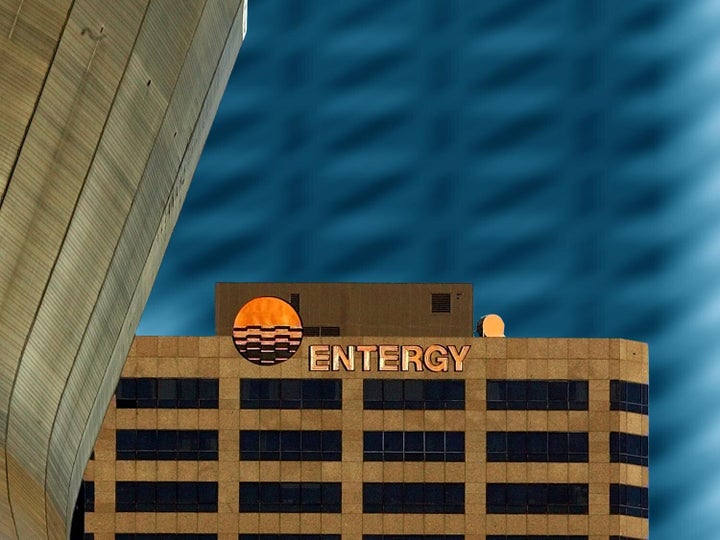
In June 2019, evangelical pastor Diedric Tupper passionately applauded a 15-year energy delivery plan from DTE Energy, Michigan’s largest utility, at a public meeting state regulators had convened.
Tupper’s short, dramatic speech was filled with utility industry talking points — renewable energy isn’t reliable or affordable for low-income residents, he claimed, and the plan’s focus on natural gas would ensure his largely Black congregation in western Michigan could keep the lights on.
“We don’t always see the light of the sun, nor do we always enjoy the coolness of wind, so there needs to be a diversity of energy in order for it to be reliable,” he said, asking the regulators to approve DTE’s plan.
Tupper’s plea shocked some of the approximately 200 Detroiters in attendance, who see DTE as a corporate villain whose poor service and high rates hit Michigan’s low-income residents the hardest ― including those Tupper claimed to represent.
But Tupper omitted relevant information: His church had received $30,000 from DTE. Similarly, six Detroit-area leaders who also praised DTE at the meeting failed to disclose that their organizations had collectively received nearly $550,000 from the company’s charitable foundation in recent years. They largely represent nonprofits or churches in low-income communities of color.
Similar relationships are common throughout the industry. A December investigation from the utility watchdog Energy and Policy Institute found utilities appear to give money to minority community leaders in exchange for political action.
The nation’s 10 largest utilities — including Duke, Dominion and Pacific Gas & Electric — spent about $1 billion on charitable giving from 2013 to 2017, partly “to manipulate politics, policies and regulation in ways designed to increase shareholder profits, often at the expense of low-income communities,” EPI wrote.
In many cases, the community leaders who benefited from those donations testified to government regulators and legislators in opposition to renewables, or in support of unpopular proposals like rate hikes. Nonprofits initially apply for grants, and in some cases utilities have stopped funding groups that oppose their agenda.
The utilities’ goal is to create the illusion of grassroots support for their agenda, especially in minority communities, said Al Weinrub, coordinator for California’s Local Clean Energy Alliance, which promotes renewable energy initiatives in the state.
He called the strategy a “pay for service arrangement.”
“The utilities say ‘We’re going to give you all these benefits and make charitable donations to your organizations, and all you guys have to do is say something good about us when we’re under fire,’” Weinrub said.
“I Call It A ‘Script”’
Aggressive public relations campaigns often supplement the policy advocacy. Detroit leaders who have received DTE funding have criticized renewable energy in op-eds, questioned stories that challenge the company and pushed industry talking points on social media. The industry has also been repeatedly caught ghostwriting op-eds and comments to regulators.
That’s partly designed to counter criticism over DTE’s service. A DTE coal plant at the edge of southwest Detroit, a majority-Latino neighborhood, has for decades poisoned the area’s air while its toxic coal ash ponds are a source of pollution around the state. Throughout Detroit, utility poles lean and wires dangerously dangle or criss-cross through tree branches, a result of the utility failing to maintain its infrastructure while making billions in payouts annually to investors in recent decades.
The grid is in such a state of disrepair that customers in low-income areas regularly go without power for days or weeks when a storm blows through the region.
DTE is now dramatically increasing rates in an attempt to fund repairs to its decaying system, and many residents of the nation’s poorest big city struggle to keep up with the utility’s spiking rates. From 2015 to 2019, DTE hit customers with an additional $775 million in charges, representing the second-largest hike in the nation during that period.
In that context, the community leaders’ support for the company felt especially “pessimistic and cynical,” said Justin Onwenu, a Detroit resident and environmental justice organizer for the Sierra Club who attended the June 2019 meeting.
“Everyone kind of gasped when they started talking about the sun not shining and wind not blowing,” he said. “From my perspective, you could see they were reading from a very detailed, prepared speech — I call it a ‘script.’”
In a statement to HuffPost, DTE said the company and its foundation are “proud of our efforts to build better neighborhoods.”
“The charities and local leaders we collaborate with provide vital services and support to members in their communities,” DTE spokesperson Peter Ternes said. Tupper didn’t respond to a request for comment.
“It’s A Strategy Of Divide And Conquer’’
EPI has documented similar activity around the country.
In New Orleans, Entergy gave more than $54 million to six nonprofits and a university whose leaders spoke in favor of the company’s plans for a natural gas plant in an African American neighborhood. After Entergy gave more than $300,000 to the Council on Aging, the nonprofit’s executive director, Howard Rodgers, told the City Council he supported Entergy’s plans because gas “does not have any kind of additional effects” on the environment.
The New Orleans City Council approved the deal, 6-1, and it was later revealed that Councilmember Cyndi Ngyuen’s nonprofit had received $6,000 from Entergy.

In Ohio, as regulators considered a Duke Energy proposal to hike residential rates by 24% in 2013, the utility gave $762,000 to five Cincinnati area organizations that spoke in favor of the proposal. Among the recipients was the Fairfield City School District. Its superintendent then praised Duke for providing “superior” service and asked regulators to “please consider the importance of the investments made and to be made by Duke Energy in order to maintain its excellent service to its customers.”
In fact, the strategy is straight out of an industry playbook. In a “tactical guide” for beating municipalization efforts that the Edison Electric Institute put together, utilities are urged to cultivate support in the community through charitable giving and tout that support in front of regulators and in marketing material, including through opinion articles.
“It may not be appropriate to ask a particular organization to actively support your position, but each organization is made up of individuals who may become active on your behalf,” the manual says.
However, the industry is now clearly asking individuals and organizations to support its agenda — a strategy that ultimately amounts to “exploitation” of communities in need, said Johanna Bozuwa, co-manager of the Democracy Collaborative, a group that tracks utility’s charitable giving.
“It’s a strategy of divide and conquer,” she said. “They’re taking people that have shared struggles and pitting them against each other, and that’s something we see in communities most affected by utility infrastructure.”
Edison Electric Institute spokesperson Brian Reil said the industry sees the strategy in a different light.
“America’s investor-owned electric companies are proud of their long history of making charitable contributions to organizations in the communities where their customers and their employees live and of engaging with members of their communities on important policy issues,” he said.
Why Utilities Give
The utilities are employing the deceptive tactic at a crucial point for the industry. Renewable programs, like rooftop solar incentives, decentralize energy, which makes delivery and production cheaper while reducing demand for utilities’ services.
Faced with an existential threat, behemoth utilities that operate on an increasingly outdated model desperately need to show regulators that there’s opposition to renewables. If that doesn’t exist, then utilities seem willing to pay to create it. From 2013 to 2017, DTE’s charitable foundation’s giving increased from $10 million annually to $15 million annually.
“A lot of utilities are spiraling, so they’re using any lever that they have to ensure that they hold on and hold power over communities,” Bozuwa said.
That’s what Weinrub sees unfolding in Northern California, where beleaguered PG&E assembled an industry-funded “alliance” of nonprofits to oppose the Community Choice program, a public authority that sells power for lower rates than what PG&E offers. The utility regularly trots out nonprofit leaders from its alliance to oppose Community Choice, Weinrub says.
“It’s really dirty politics, and they’re pulling this out around issues that have to do with climate change and the transition to renewables so they can protect corporate interest and assets,” Weinrub said.
The utilities likely target minority nonprofits and low-income communities because those areas bear the brunt of utilities’ plans, EPI’s Kasper said. New gas plants aren’t built in wealthy white neighborhoods, and rate hikes hurt low-income residents the most.
“The utilities know that if they want their plans to go through, then they may need voices from those areas to speak on their behalf,” Kasper said.
Nonprofits and pastors serving marginalized communities are also often in dire need of money and can be susceptible to exploitation, said Jessica Guadalupe-Tolvar, a Local Clean Energy organizer in California.
“But, at the same time, that’s pacifying the community’s ability to speak out when there’s an incident like an explosion,” she said. “At the same time, [nonprofits] are signing away their ability to advocate against a corporation that’s giving them money.”
Utilities also seem to view Black communities as a critical bloc for support for public policy, said Jacqui Patterson, director of the NAACP’s Environmental and Climate Justice Program. In 2012, she watched as DTE poured money into Black communities around Detroit as part of a successful campaign to defeat a ballot proposal that would’ve required 25% of the state’s energy to come from renewable sources by 2025.
“I think at the end of the day, the companies see [Black customers] as influencers,” she said.
Patterson added that she doesn’t believe those taking money are corrupt. The message utilities deliver to minority leaders — clean energy benefits the wealthy while burdening the poor — sounds reasonable.
“They’re good at being able to explain things using an equity lens, so it’s not that they’re just straight-up buying people off and people are allowing themselves to be used — it’s a lot more sophisticated than that,” she said.
“It’s No Secret”
It’s unclear whether regulators see through the ploy. EPI highlighted comments from a Tennessee utility regulator who recently praised an unnamed company for giving money to “inner city” charities to placate opposition to the utility’s plans.
Florida’s top consumer advocate, J.R. Kelly, labeled nonprofit executives who advocate for private utilities “shills.”
“They show up because Florida Power and Light gives them money,” Kelly told the Palm Beach Post. “It’s no secret.”
In Michigan, Matt Helms, a spokesperson for the Michigan Public Services Commission, said it “has not researched funding of any individuals or organizations participating in the [June DTE] public meeting.” However, it was made aware of the financial ties after the meeting.
Helms noted that the MPSC sent DTE “back to the drawing board,” partly because of the plan’s lack of emphasis on renewables.
Onwenu said it should be clear to everyone involved what’s going on.
“It would be different if there were community folks coming out of the woodwork in support of DTE, but all the people who spoke for [the company] were in some way financially connected to it, and that seems to be way too convenient of a coincidence.”
CORRECTION: An earlier version of this story misspelled Al Weinrub’s surname.
